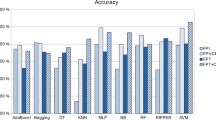Abstract
Changes in eye movements have a strong relationship with the changes in the brain. Several medical studies have revealed that in most CNS disorders, ocular manifestations are often associated with brain symptoms. To date, computational intelligence has not been used to study the relationship between eye movements and brain disorders. We propose a support vector machine (SVM) based machine learning solution to identify, five disorders related to the central nervous system; Amyotrophic Lateral Sclerosis (ALS), Multiple Sclerosis (MS), and Alzheimer’s Disease (AD), Parkinson’s Disease (PD), and Schizophrenia. Apart from the SVM, the proposed solution handles two major problems which occur in the data preprocessing stage; insufficiency of real eye test data and finding optimal features set for a particular disorder. An algorithm is developed to generate synthetic data and to find the optimal features set for a particular disorder, a solution based on particle swarm optimization is proposed. We trained the SVM models using the generated synthetic data and tested with the real data. The proposed system based on SVMs with linear, polynomial, and RBF kernels were able to identify the stages of the disorders, as diagnosed in medical studies. The SVM with the RBF kernel worked with an accuracy of 97% in identifying the existence of a CNS disorder. In classifying the stages of ALS, the linear kernel worked with an accuracy of 77% while the polynomial kernel worked with an accuracy of 100%, 90%, and 64% in classifying stages of MS, AD, and Schizophrenia. For PD, SVMs with all kernels gave an accuracy of 96%. The results are encouraging, giving sufficient evidence that the proposed system works better. We further illustrate the viability of our method by comparing the results with those obtained in previous medical studies.
Access this chapter
Tax calculation will be finalised at checkout
Purchases are for personal use only
Similar content being viewed by others
References
Spearman Rank Correlation Coefficient, pp. 502–505. Springer, New York (2008). https://doi.org/10.1007/978-0-387-32833-1_379
Brindle, A.: Genetic algorithms for function optimization, University of Alberta (1980)
Chakraborti, N.: Genetic algorithms in materials design and processing. Int. Mater. Rev. 49(3–4), 246–260 (2004)
Chang, C.K., Christensen, M.J., Zhang, T.: Genetic algorithms for project management. Ann. Softw. Eng. 11(1), 107–139 (2001)
Cortes, C., Vapnik, V.: Support-vector networks. Mach. Learn. 20(3), 273–297 (1995)
Hajihassani, M., Armaghani, D.J., Kalatehjari, R.: Applications of particle swarm optimization in geotechnical engineering: a comprehensive review. Geotech. Geol. Eng. 36(2), 705–722 (2018)
Holland, J.H.: Genetic algorithms. Sci. Am. 267(1), 66–73 (1992)
Kennedy, J., Eberhart, R.: Particle swarm optimization. In: Proceedings of ICNN’95-International Conference on Neural Networks, vol. 4, pp. 1942–1948. IEEE (1995)
Kim, J.I., Kang, B.H.: Decreased retinal thickness in patients with Alzheimer’s disease is correlated with disease severity. PLoS ONE 14(11), e0224180 (2019)
Kromer, R., et al.: Evaluation of retinal vessel morphology in patients with Parkinson’s disease using optical coherence tomography. PLoS ONE 11(8), e0161136 (2016)
Kulkarni, R.V., Venayagamoorthy, G.K.: Particle swarm optimization in wireless-sensor networks: a brief survey. IEEE Trans. Syst. Man Cybernet. Part C (Appl. Rev.) 41(2), 262–267 (2010)
Liu, Y., Huang, L., Tong, Y., Chen, J., Gao, D., Yang, F.: Association of retinal nerve fiber abnormalities with serum CNTF and cognitive functions in schizophrenia patients. Peer J. 8, e9279 (2020)
London, A., Benhar, I., Schwartz, M.: The retina as a window to the brain-from eye research to CNS disorders. Nat. Rev. Neurol. 9(1), 44–53 (2013)
Mukherjee, N., McBurney-Lin, S., Kuo, A., Bedlack, R., Tseng, H.: Retinal thinning in amyotrophic lateral sclerosis patients without ophthalmic disease. PLoS ONE 12(9), e0185242 (2017)
Rana, S., Jasola, S., Kumar, R.: A review on particle swarm optimization algorithms and their applications to data clustering. Artif. Intell. Rev. 35(3), 211–222 (2011)
Renner, G., Ekárt, A.: Genetic algorithms in computer aided design. Comput. Aided Des. 35(8), 709–726 (2003)
Salobrar-García, E., et al.: Changes in visual function and retinal structure in the progression of Alzheimer’s disease. PloS ONE 14(8), e0220535 (2019)
Sanchez-Dalmau, B., et al.: Predictors of vision impairment in multiple sclerosis. PLoS ONE 13(4), e0195856 (2018)
Author information
Authors and Affiliations
Corresponding author
Editor information
Editors and Affiliations
Rights and permissions
Copyright information
© 2023 The Author(s), under exclusive license to Springer Nature Switzerland AG
About this paper
Cite this paper
Samarasinghe, U.S., Ariyaratne, M.K.A. (2023). An Expert System to Detect and Classify CNS Disorders Based on Eye Test Data Using SVM and Nature-Inspired Algorithms. In: Rutkowski, L., Scherer, R., Korytkowski, M., Pedrycz, W., Tadeusiewicz, R., Zurada, J.M. (eds) Artificial Intelligence and Soft Computing. ICAISC 2022. Lecture Notes in Computer Science(), vol 13589. Springer, Cham. https://doi.org/10.1007/978-3-031-23480-4_15
Download citation
DOI: https://doi.org/10.1007/978-3-031-23480-4_15
Published:
Publisher Name: Springer, Cham
Print ISBN: 978-3-031-23479-8
Online ISBN: 978-3-031-23480-4
eBook Packages: Computer ScienceComputer Science (R0)




